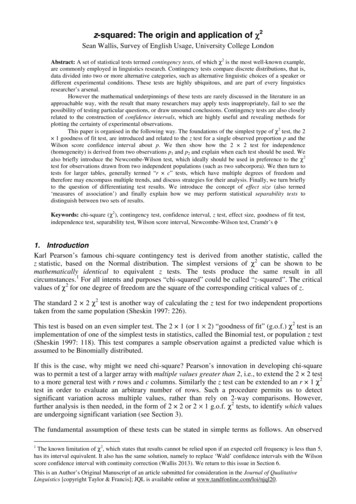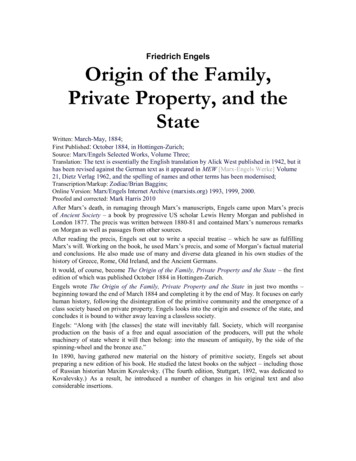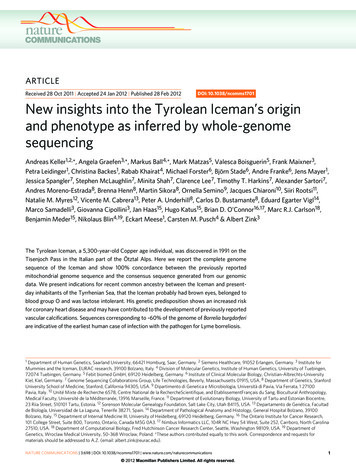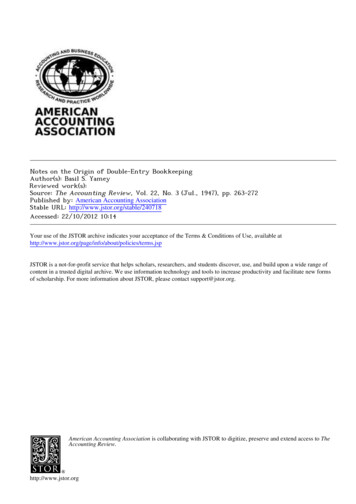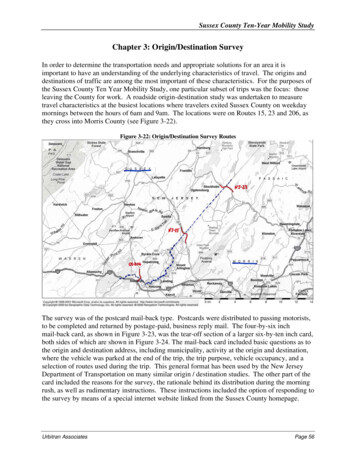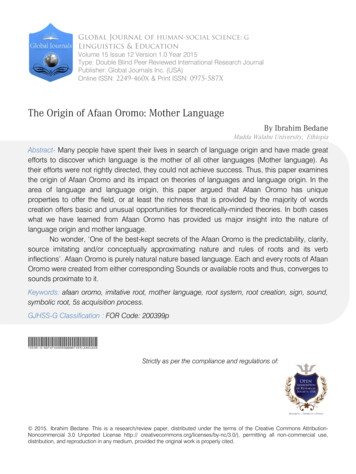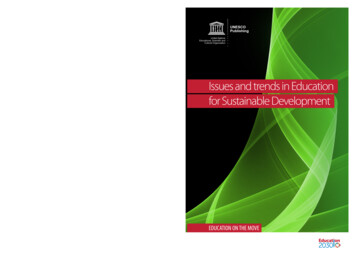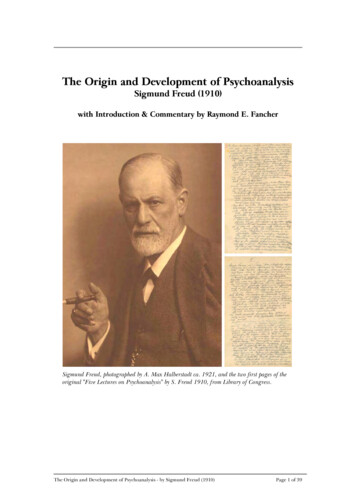
Transcription
The Origin and Development of PsychoanalysisSigmund Freud (1910)with Introduction & Commentary by Raymond E. FancherSigmund Freud, photographed by A. Max Halberstadt ca. 1921, and the two first pages of theoriginal "Five Lectures on Psychoanalysis" by S. Freud 1910, from Library of Congress.The Origin and Development of Psychoanalysis - by Sigmund Freud (1910)Page 1 of 39
First published in American Journal of Psychology, 21, 181-218. These five lectures weredelivered at the Celebration of the Twentieth Anniversary of the opening of ClarkUniversity, Sept., 1909; translated from German by Harry W. Chase, Fellow in Psychology,Clark University, and revised by Prof. Freud.Published with the kind permission of Christopher D. Green, York University, Toronto,Ontario, and Raymond E. Fancher, York University.Originally published in html-format at Classics in the History of on and commentary by Raymond E. Fancher, York University, 1998 RaymondE. Fancher. All rights reserved.This E-book was created by Dennis Nilsson 2006,Digital Nature Agency: http://dnagency.hopto.orgThanks to Christopher D. Green & Raymond E. Fancher for suggestions & proofreading.LicensingThis file is licensed under the CreativeCommons Attribution ShareAlike 2.5 License:I, the creator of this file, hereby publish it under thefollowing license: You are free to copy, distribute, display, andperform the work, and to make derivative works, under thefollowing conditions:1. You must give the original authors & sources credit. 2. Youmay not use this work for commercial purposes. 3. If youalter, transform, or build upon this work, you may distributethe resulting work only under a licence identical to this .5ContentsIntroduction to "The Origin and Development of Psychoanalysis." . 3Recommended Reading . 5Notes . 5The Origin and Development of Psychoanalysis . 61. First Lecture. 62. Second Lecture . 123. Third Lecture . 164. Fourth Lecture. 225. Fifth Lecture . 27Commentary on "The Origin and Development of Psychoanalysis." . 31Freud's Early Life. 31Studies on Hysteria . 32Dream Interpretation and Self-analysis . 34Freud's Major Works . 36Suggested Reading . 38Sources . 39The Origin and Development of Psychoanalysis - by Sigmund Freud (1910)Page 2 of 39
Introduction to "The Origin andDevelopment of Psychoanalysis."by Raymond E. Fancher, York University 1998 Raymond E. Fancher. All rights reserved.In December of 1908, the Viennese physician Sigmund Freud (1856-1939) received anintriguing invitation from the American psychologist G. Stanley Hall (1844-1924), invitinghim to visit Clark University in Worcester, Massachusetts, and deliver a series of lecturesdescribing his novel views about abnormal psychology. The invitation was intriguing partlybecause it came from one of the senior and most influential figures in American psychology.A prolific author and researcher, Hall had pioneered the field of developmental psychologyand brought both the term and the concept of "adolescence" to wide public notice. He hadalso been America's leading institution builder for the emerging discipline of psychology,establishing The American Journal of Psychology as his country's first professional psychologyjournal in 1887, and serving as the founding president of the American PsychologicalAssociation in 1892. Since 1889 he had been president of Clark University, which despite itssmall size had become the leading American producer of Ph.D. students in psychology.Indeed, Hall was just now planning a conference to celebrate the University's 20thanniversary, which he assured Freud would attract "the best American professors andstudents of psychology and psychiatry," and which was the occasion for the presentinvitation. 1Freud was flattered to receive an invitation from such an eminent representative of thepsychological establishment, for he himself was anything but an establishment figure. Formore than twenty of his fifty-two years he had been developing an innovative psychologicaltheory and treatment method that he called "psychoanalysis," but even though he hadpublished extensively in respectable German language journals his work had not "taken off"in the way the ambitious Freud had hoped it would. As Freud later put it, he had spent thedecade of the 1890s working in "splendid isolation" and only after the 1900 publication of hisbook Die Traumdeutung (The Interpretation of Dreams) had he begun to attract a small followingin Europe. A few young Viennese intellectuals started meeting regularly at his home todiscuss his work, occasionally joined by outside visitors such as Karl Abraham (1877-1925)from Berlin, Sandor Ferenczi (1873-1933) from Budapest, and Carl Jung (1875-1961) fromZurich. By April of 1908 this group had become large and enthusiastic enough to organize a"First International Congress of Psychoanalysis" in the Austrian city of Salzburg, whichattracted some forty participants from five countries. But this was still relatively small stuff.Almost all of the writing about psychoanalysis was still in German and its reputation wasprimarily confined to continental Europe; even there, it was distinctly a fringe movement. InAmerica and the rest of the English speaking world, some rumors had begun to spreadabout Freud as the promoter of a strange and sensational new theory that emphasizedsexuality and the unconscious, but few had any direct knowledge of him or his work. Hall,who had emphasized sexuality in his own theorizing about child development andadolescence, was among the first Americans to read Freud in the original and to be positivelyimpressed. Hence the invitation.1G. Stanley Hall to Sigmund Freud, letter of 15 December 1908, reprinted in S. Rosenzweig, The Historic Expeditionto America (1909): Freud, Jung and Hall the King-maker (St. Louis: Rana House, 1994), p. 339.The Origin and Development of Psychoanalysis - by Sigmund Freud (1910)Page 3 of 39
Following negotiations during which the date of the conference was changed to a moreconvenient time, the speaker's honorarium increased from 400 to 750, and Freud wasoffered an honorary degree if he came, he accepted. Despite some uneasiness about thereceptivity of American culture to his work, Freud recognized the invitation as offering awonderful platform from which to present his theory directly to a new and prestigious groupof psychologists, under the official sponsorship of a highly respected American institution.He arranged to bring his Hungarian disciple Ferenczi along for moral support, andconvinced Hall to issue Jung a last minute invitation to address the conference as well. Freudand his party sailed to New York aboard the ocean liner George Washington in late August,and arrived in Worcester for the early September conference.Freud delivered five lectures on five consecutive days from Tuesday, September 7 throughSaturday the 11th. Given in German and following no written text, each wasextemporaneously planned on a walk with Ferenczi earlier in the day. Despite theseapparent limitations, the talks were a great success. His audience was more multilingual thanwould be the case for a comparable gathering today, and Freud fully revealed his skill as acogent and captivating lecturer, sprinkling his talks with small jokes and personal referencesthat everyone enjoyed. His lectures told the story, in roughly chronological order, of how hehad arrived at the main points of his theory and technique. Although more than twentyspeakers participated in the conference, Hall clearly promoted Freud as the star attraction,and his lectures received wide press coverage. Although not everyone was convinced byeverything Freud had to say, his goals for the visit were more than realized. He provided alucid summary of his complicated theories, in terms easily understood and remembered byintelligent laypeople.Hall liked the lectures very much, and wanted to preserve them in a more permanent anddefinitive form than just newspaper accounts. Accordingly, he wrote to Freud shortly afterhis return to Vienna: "Your lectures were such masterpieces of simplification, directness, andcomprehensiveness that we all think that for us to print them here would greatly extendyour views at a psychological moment here and would do very much toward developing infuture years a strong American school." 2 If Freud would agree to recreate the lectures inwriting by the next January, Hall would have them translated into English and published inthe American Journal of Psychology. Freud readily agreed, and after working "head over heelsto meet the imminent deadline you have set for me" 3 , produced the five written lectures ontime. Although slightly amended to accommodate the written medium, they faithfullyrecaptured the substance and spirit of his original talks. As they arrived one by one, Hallimmediately sent them for translation to his student Harry W. Chase, who was concurrentlycompleting a doctoral dissertation on the new Freudian psychology. After some frantictransatlantic exchanges for Freud to approve the translations, they duly appeared in theApril issue of the journal under the title, "The Origin and Development of Psychoanalysis,"in the exact form in which they appear below. Later in 1910 Freud published his Germanversion of the lectures, in a small book that he gratefully dedicated to Hall.In the following years Freud's enthusiasm for Hall dimmed somewhat, as the Americanbegan to endorse some of the views of Alfred Adler, Freud's early follower who had brokenwith psychoanalysis and established a competing school of "Individual Psychology." Freudcomplained that Hall too much enjoyed playing the role of "kingmaker," and was fickle in hisdevotion to those he had previously anointed. Nonetheless he was correct to be grateful toHall, for the lectures and their attendant honors and publicity marked a genuine turning23Hall to Freud, letter of 7 October 1909, reprinted in Rosenzweig, 1994, pp. 358-359.Freud to Hall, letter of 21 November 1909, reprinted in Rosenzweig, 1994, p. 363.The Origin and Development of Psychoanalysis - by Sigmund Freud (1910)Page 4 of 39
point. Now accessible for the first time to a wide audience, Freud and psychoanalysis werefairly on their way to becoming household terms, in America as well as Europe.Freud's German version of the lectures has subsequently been re-translated into English,mainly to make all of their terminology consistent with the more recent "Standard Edition" ofFreud's work. But the essence of all versions remains the same, and the original translationpresented here has the historical virtue of enabling the reader to encounter Freud in exactlythe same way his American audience first did in 1910. There is still no better shortintroduction to the man and his work.Recommended ReadingFor a full and fascinating account of Freud's trip to America, accompanied by his completecorrespondence with Hall and one of the new translations of the lectures, see SaulRosenzweig's The Historic Expedition to America (1909): Freud, Jung and Hall the King-maker (St.Louis: Rana House, 1994). Also see R. B. Evans and W. A. Koelsch (1985), Psychoanalysisarrives in America: The 1909 psychology conference at Clark University, AmericanPsychologist, 40, 942-948.Notes1. G. Stanley Hall to Sigmund Freud, letter of 15 December 1908, reprinted in S.Rosenzweig, The Historic Expedition to America (1909): Freud, Jung and Hall the King-maker (St.Louis: Rana House, 1994), p. 339.2. Hall to Freud, letter of 7 October 1909, reprinted in Rosenzweig, 1994, pp. 358-359.3. Freud to Hall, letter of 21 November 1909, reprinted in Rosenzweig, 1994, p. 363.The Origin and Development of Psychoanalysis - by Sigmund Freud (1910)Page 5 of 39
The Origin and Development ofPsychoanalysis1Sigmund Freud (1910)1. First LectureLadies and Gentlemen: It is a new and somewhat embarrassing experience for me to appearas lecturer before students of the New World. I assume that I owe this honor to theassociation of my name with the theme of psychoanalysis, and consequently it is ofpsychoanalysis that I shall aim to speak. I shall attempt to give you in very brief form anhistorical survey of the origin and further development of this new method of research andcure.Granted that it is a merit to have created psychoanalysis, it is not my
establishing The American Journal of Psychology as his country's first professional psychology journal in 1887, and serving as the founding president of the American Psychological Association in 1892. Since 1889 he had been president of Clark University, which despite its small size had become the leading American producer of Ph.D. students in psychology. Indeed, Hall was just now planning a .
